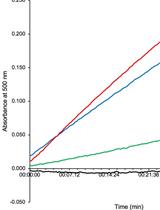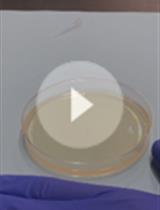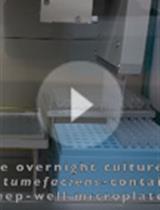- EN - English
- CN - 中文
Bacterial Competition Assay Based on Extracellular D-amino Acid Production
基于细胞外D-氨基酸生成的细菌竞争测定
发布: 2018年04月05日第8卷第7期 DOI: 10.21769/BioProtoc.2787 浏览次数: 9111
评审: Emily CopeAnonymous reviewer(s)

相关实验方案

从垢分支杆菌中通过双功能酶,4-氨基-4-脱氧胆固醇裂解酶/D-氨基酸转氨酶、转氨酶产生的D-谷氨酸的检测
Helen K. Opel-Reading [...] Kurt L. Krause
2019年01月05日 5709 阅读
Abstract
Bacteria live in polymicrobial communities under tough competition. To persist in a specific niche many species produce toxic extracellular effectors as a strategy to interfere with the growth of nearby microbes. One of such effectors are the non-canonical D-amino acids. Here we describe a method to test the effect of D-amino acid production in fitness/survival of bacterial subpopulations within a community. Co-cultivation methods usually involve the growth of the competing bacteria in the same container. Therefore, within such mixed cultures the effect on growth caused by extracellular metabolites cannot be distinguished from direct physical interactions between species (e.g., T6SS effectors). However, this problem can be easily solved by using a filtration unit that allows free diffusion of small metabolites, like L- and D-amino acids, while keeping the different subpopulations in independent compartments.
With this method, we have demonstrated that D-arginine is a bactericide effector produced by Vibrio cholerae, which strongly influences survival of diverse microbial subpopulations. Moreover, D-arginine can be used as a cooperative instrument in mixed Vibrio communities to protect non-producing members from competing bacteria.
Background
Bacteria live in polymicrobial communities where a great diversity of species coexist and compete for the available resources. One of the many tactics that bacteria have devised to persist in a specific niche is the production of toxic extracellular metabolites as a strategy to interfere with growth and/or viability of other microbes. D-amino acids have been known for a long time to have a powerful effect in cell shape and viability in bacterial cultures (Bopp, 1965; Fox et al., 1944; Kobayashi et al., 1948; Yaw and Kakavas, 1952; Lark and Lark, 1959; Grula, 1960; Tuttle and Gest, 1960). However, it has not been until recently that D-amino acids have gained physiological meaning when it was reported that many taxonomically unrelated bacteria could release millimolar concentrations of non-canonical D-amino acids (NCDAAs) to the extracellular medium (Lam et al., 2009). Vibrio cholerae, the causative agent of the diarrheal disease cholerae, presents a periplasmic broad spectrum racemase called BsrV reported to produce a great variety of D-amino acids, mainly D-Met and D-Leu (Lam et al., 2009; Cava et al., 2011). Further studies demonstrated that the main mode of action of these D-amino acids was through their incorporation into the peptidoglycan polymer, an essential bacterial structure that plays a role in morphology determination and cell integrity (Caparros et al., 1992; Lam et al., 2009; Cava et al., 2011). Peptidoglycan is a macromolecule composed of glycan chains crosslinked by short peptides. Interestingly, NCDAAs can be incorporated into the peptidoglycan into the 4th or the 5th residue of the peptide stem of the muropeptide subunits and this editing has a key role in synchronizing cell wall metabolism with growth arrest (Lam et al., 2009; Cava et al., 2011).
A recent study demonstrated that the cell wall is not the only target of non-canonical D-amino acids (Alvarez et al., 2018). V. cholerae and many other bacteria produce a great variety of D-amino acids which have distinct functions (Lam et al., 2009; Alvarez et al., 2018). D-arginine stands out as a fitness modulator of bacterial subpopulations, since it shows a significantly higher growth inhibitory activity against a wide diversity of bacterial species compared with other D-amino acids. In contrast to D-methionine, which has a major modulatory role in cell wall biosynthesis, D-arginine growth inhibition is suppressed by mutations in the chaperone systems and the phosphate uptake machinery in several model organisms, strongly supporting different roles for NCDAAs in bacterial physiology (Alvarez et al., 2018).
Co-cultivation is an excellent method to assess the inhibitory effect of D-arginine in mixed bacterial populations. However, when the competing bacteria present very different growth rates (e.g., V. cholerae and Caulobacter crescentus used in this study), relative cell counting can be challenging. Besides, it might be difficult to assess the role of small metabolites in species competition when other mechanisms, such as cell-to-cell dependent interactions (e.g., T6SS), can occur simultaneously. Here we present a method to assess the effect of small metabolites on bacterial populations. The design is based in the compartmentalization of the competing subpopulations in two independent rooms separated by a filter that permits diffusion of small metabolites such as amino acids. Furthermore, this method can be used to demonstrate the metabolic cooperation between producer and non-producer bacteria (e.g., V. cholerae wild-type and ΔbsrV mutant) that share extracellular D-amino acids to outcompete other species in the environment. Finally, we also describe the methodology to determine the total D-amino acid concentration in the media.
Materials and Reagents
- Wired-loop or disposable inoculation loops (SARSTEDT, catalog number: 86.1562.050 )
- 15 ml test tubes (SARSTEDT, catalog number: 62.554.502 )
- Cuvettes (SARSTEDT, catalog number: 67.742 )
- 150 ml Stericup filtration units, 0.22 µm pore size (Merck, catalog number: SCGPU01RE )
- Adhesive tape
- Parafilm (Sigma-Aldrich, catalog number: P7793-1EA )
- Needles (BD, catalog number: 302200 )
- Syringes 1 ml, 10 ml (BD, catalog numbers: 303172 , 307736 )
- 1.5 ml microtubes (Eppendorf, catalog number: 0030120086 )
- Sterile clear flat-bottom 96-well plates with lid (Corning, Falcon®, catalog number: 353072 )
- Sterile glass beads 3 mm (Merck, catalog number: 1040150500 )
- Petri dishes (SARSTEDT, catalog number: 82.1473 )
- Filter units, 0.22 µm pore size (Merck, catalog number: SLGS033SB )
- Disposable pipette tips (VWR, catalog numbers: 613-1083 , 613-1079 , 613-1077 )
- Bacterial strains: V. cholerae N16961 lacZ+ wild-type, V. cholerae N16961 lacZ- ΔbsrV, Caulobacter crescentus NA1000
- Trigonopsis variabilis DAAO (gift from Jose M. Guisan, Catalysis Department, ICP – CSIC, Spain) (Komarova et al., 2012)
- L-Arginine (L-Arg) (Sigma-Aldrich, catalog number: A5006-100G )
- D-Arginine (D-Arg) (Sigma-Aldrich, catalog number: A2646-5G )
- Distilled water
- MilliQ water
- Hydrochloric acid fuming 37% (HCl) (Merck, catalog number: 1003171000 )
- Tryptone (Peptone from casein) (VWR, catalog number: 84610.0500 )
- Yeast extract (VWR, catalog number: 84601.0500 )
- Sodium chloride (NaCl) (Sigma-Aldrich, catalog number: 71376-1KG )
- Sodium hydroxide pellets (NaOH) (Merck, catalog number: 1064821000 )
- Peptone, meat (enzymatic digest of animal tissue) (VWR, catalog number: 84620.0500 )
- Magnesium sulfate (MgSO4) (Sigma-Aldrich, catalog number: M2643-500G )
- Calcium chloride (CaCl2) (Sigma-Aldrich, catalog number: C5670-500G )
- Bacteriological agar (VWR, catalog number: 84609.0500 )
- Sodium phosphate monobasic monohydrate (NaH2PO4·H2O) (Sigma-Aldrich, catalog number: 71507-250G )
- Sodium phosphate dibasic heptahydrate (Na2HPO4·7H2O) (Sigma-Aldrich, catalog number: 431478-250G )
- Ortho-phosphoric acid 85% (Merck, catalog number: 1005731000 )
- Flavin adenine dinucleotide disodium salt hydrate (FAD) (Sigma-Aldrich, catalog number: F6625-100MG )
- o-Phenylenediamine (OPD) (Sigma-Aldrich, catalog number: P23938-5G )
- Methanol (VWR, catalog number: 20847.307 )
- Horseradish peroxidase (Sigma-Aldrich, catalog number: 77332-100MG )
- LB medium (see Recipes)
- PYE medium (see Recipes)
- Agar plates (see Recipes)
- L- and D-amino acid stock solutions (see Recipes)
- Sodium phosphate buffer 500 mM pH 7.5 (see Recipes)
- DAAO reaction buffer (see Recipes)
Equipment
- Laminar flow cabinet
- Bunsen burner
- Pipettes (Gilson, catalog numbers: F144563 , F144565 , F144566 )
- Multichannel pipettes (Gilson, catalog number: F14403 )
- Glassware: bottles, measurement cylinders, beakers
- pH-meter (VWR, catalog number: 662-1422 )
- Autoclave (CertoClav, catalog number: 8510174 )
- Incubator (Memmert, catalog number: IN55 )
- Shaker incubator (Thermo Fisher Scientific, Thermo ScientificTM, model: MaxQTM 5000, catalog number: SHKE5000 )
- Thermomixer with adapter for multi-well plates (Eppendorf, catalog numbers: 5355000011 , 5363000012 )
- Spectrophotometer (GE Healthcare, catalog number: 29003605 )
- Microplate reader (Biotek, model: EONTM, catalog number: EONC )
Procedure
文章信息
版权信息
© 2018 The Authors; exclusive licensee Bio-protocol LLC.
如何引用
Alvarez, L. and Cava, F. (2018). Bacterial Competition Assay Based on Extracellular D-amino Acid Production. Bio-protocol 8(7): e2787. DOI: 10.21769/BioProtoc.2787.
分类
微生物学 > 微生物生理学 > 种间竞争
微生物学 > 微生物信号传导 > 种间交流
生物化学 > 其它化合物 > 氨基酸 > D型氨基酸
您对这篇实验方法有问题吗?
在此处发布您的问题,我们将邀请本文作者来回答。同时,我们会将您的问题发布到Bio-protocol Exchange,以便寻求社区成员的帮助。
Share
Bluesky
X
Copy link











